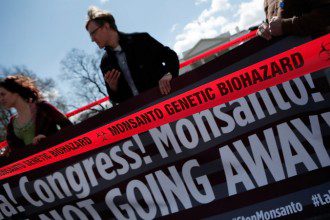26th November 2015
Contributing Writer for Wake Up World
“Agrochemical giant Monsanto knowingly contaminated Oakland’s storm water and the San Francisco Bay with a highly toxic chemical for decades, a new lawsuit filed by the California city claims. Oakland wants the company to pay for the environmental cleanup.” [source]
Municipalities in the U.S. are fed-up with Monsanto’s corrupt tactics — and they’re hitting the corporation where it hurts: their pocketbook. Oakland California, the latest city to sue the biotech colossus, has filed a lawsuit seeking retribution for damages caused by harmful polychlorinated biphenyl (PCB) contamination.
In a press release by the city last Tuesday, The State Water Resources Control Board found that PCBs present in Oakland’s storm water is a threat to the entire San Fransisco Bay’s ecosystem.
According to Oakland City Attorney, Barbara J. Parker, “Monsanto knew that PCBs were toxic and could not be contained as they readily escaped into the environment, finding their way into bays, oceans, lakes, rivers, streams, soil and air… Although evidence confirms that Monsanto recognized that PCBs were becoming ‘a global contaminant’, well before the 1979 ban, it concealed this information and increased production of these profitable compounds.” [Source]
Oakland and Alameda County could face $1 billion in cleanup expenses for removing PCBs from storm water flowing into the San Francisco Bay. The lawsuit is demanding Monsanto cover these costs. City Attorney Parker continues:
“The company that is responsible for this vast contamination should bear the burden of cleaning up our environment, not the taxpayers of Oakland and California… Monsanto knew that its products posed a significant threat to human and environmental health around the world. However, the company chose profits over protecting people, and American cities and citizens are still suffering the consequences.” [Source]
PCBs were heavily used over five decades to insulate electronics and were added to paints, caulks and a variety of building materials. The chemical was banned in 1979, but, due to its highly unreactive nature, PCBs persist in the ecosystem to this day and are found in human blood, milk and fatty tissue — as well as meat, fish and dairy products. The chemical is associated with cancer and negatively impacts immune, reproductive, nervous and endocrine systems.
A History of Legal Entanglement
This isn’t the first time Monsanto has come under fire for poisoning and polluting. Below is a small sampling of legal suits brought against the company.
- The corporation settled multiple lawsuits by the city and community members of Anniston, Alabama — which is considered the most heavily PCB-contaminated site in the United States. As of 2002, the corporation paid out $700 million total — with $600 million to residents and the remaining $100 million to address contamination.
- In 2012, a French farmer won his legal battle against the corporation for chemical poisoning, setting a precedent in the French legal system for pesticide-poisoning. Several months later, a similar case appeared in Argentina, where farmers claimed the corporation knowingly poisoned them with agricultural pesticides after coercing the farmers into using the chemicals.
- Monsanto also manufactured the notorious chemical Agent Orange, which was used as a defoliant during the Vietnam War and caused horrific illnesses along with disabilities. It appears 2012 wasn’t a good year for the corporation, as it was forced to shell out $84 million for a 30-year monitoring program in West Virginia, where its Agent Orange plant was located. Monsanto also had to pay an additional $9 million towards cleaning up contaminated regions.
- In November 2014, U.S. wheat farmers won a legal suit against Monsanto with a payout of $2.4 million, after the corporation’s genetically engineered strain of Roundup Ready wheat showed up in the their crops.
- Earlier this year, three American cities brought legal suits against the corporation — Spokane, Washington as well as San Diego and San Jose, both of which are located in California. The cities claim the company sold PCB-laden chemicals, even though the company was aware for decades of their toxic nature.
What does Monsanto have to say about this latest lawsuit from the City of Oakland? True to form, the corporation denies any responsibility whatsoever for PCB contamination. NBC News reports:
“Monsanto today, and for the last decade, has been focused solely on agriculture, but we share a name with a company that dates back to 1901. The former Monsanto was involved in a wide variety of businesses including the manufacture of PCBs. PCBs were industrial chemicals, which were sold to sophisticated companies who incorporated them as safety fluids into electrical equipment, into plastics, and into thousands of useful construction and building material products. PCBs served an important fire protection and safety purpose for the electrical and other industries. The manufacture of PCBs in the United States was banned in 1979, although the former Monsanto voluntarily ceased production and selling before that.
We are reviewing the lawsuit and its allegations. However, Monsanto is not responsible for the costs alleged in this matter. PCBs sold at the time were a lawful and useful product that was then incorporated by third parties into other useful products. If improper disposal or other improper uses created the necessity for clean-up costs, then these other third parties would bear responsibility for these costs.”
As far as Monsanto is concerned, we can just ignore the inconvenient fact that the company knew for over forty years PCBs were hazardous — yet chose profit over ethics.
In other words, it’s simply business as usual for the corrupt corporation.
For more information, please see: The Beginning of the End for Monsanto? Communities Fight Back Against Chemical Contamination.
Article sources:
- www.oaklandcityattorney.org/News/Press%20releases/PCB%20lawsuit.html
- www.rt.com/usa/321630-oakland-monsanto-contamination-lawsuit
- www.nbcbayarea.com/news/local/Oakland-Sues-Monsanto-For-PCB-Pollution-in-San-Francisco-Bay-345968132.html
- www.sfbay.ca/2015/11/10/oakland-sues-monsanto-over-pcb-runoff
Previous articles by Carolanne Wright:
- Considering the Flu Shot? Here are Five Reasons to Think Twice
- Dr Sebi: The Man Who Cures Aids, Cancer, Diabetes and More
- Plastic-Eating Mushroom Discovered in the Amazon Rainforest — A Solution for Our Trash Saturated World?
- Chronic Lyme Disease: A Modern Plague the Government Chooses to Ignore
- Big Pharma and Organized Crime — They are More Similar Than You May Think
- Over 100 Scientific Studies Agree: Cannabis Annihilates Cancer
- Emotional Energetic Healing: The Future of Medicine is Here
- Why Every Parent Should Consider Unschooling
- The Greenhouse of the Future: Grow Your Own Food Year-Round With This Revolutionary System
- First U.S. City Produces More Electricity Than It Uses — With 100% Renewable Technology
- Autistic Boy with Higher IQ Than Einstein Discovers Gift After Removal from State-Run Therapy
About the author:
I’m Carolanne — a writer, chef, traveler and enthusiastic advocate for sustainability, organics and joyful living. It’s good to have you here. If you would like to learn more, connect with me at Thrive-Living.net or visit Twitter.com/Thrive_Living.

If you've ever found value in our articles, we'd greatly appreciate your support by purchasing Mindful Meditation Techniques for Kids - A Practical Guide for Adults to Empower Kids with the Gift of Inner Peace and Resilience for Life.
In the spirit of mindfulness, we encourage you to choose the paperback version. Delve into its pages away from screen glare and notifications, allowing yourself to fully immerse in the transformative practices within. The physical book enriches the learning process and serves as a tangible commitment to mindfulness, easily shared among family and friends.
Over the past few years, Wake Up World has faced significant online censorship, impacting our financial ability to stay online. Instead of soliciting donations, we're exploring win-win solutions with our readers to remain financially viable. Moving into book publishing, we hope to secure ongoing funds to continue our mission. With over 8,500 articles published in the past 13 years, we are committed to keeping our content free and accessible to everyone, without resorting to a paywall.








